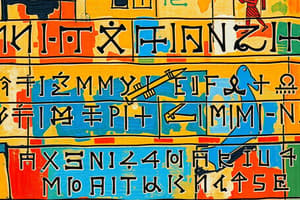Podcast
Questions and Answers
What was the primary purpose of the clay tokens used in early Mesopotamian accounting?
What was the primary purpose of the clay tokens used in early Mesopotamian accounting?
- To represent written language
- To create artistic representations
- To label and keep track of goods (correct)
- To convey religious messages
How did cuneiform evolve from its original form?
How did cuneiform evolve from its original form?
- From clay tokens to abstract art
- From pictographs to an entirely phonetic system
- From full words to numerical symbols
- From 3D representations to pictographs (correct)
What characterized the shift from Mesopotamian cuneiform to the Phoenician alphabet?
What characterized the shift from Mesopotamian cuneiform to the Phoenician alphabet?
- Simplification to represent only consonants (correct)
- Introduction of vowel representations
- Adoption of more complex characters
- Return to pictographic symbols
Which archaeological find was crucial in decoding Babylonian cuneiform?
Which archaeological find was crucial in decoding Babylonian cuneiform?
What aspect of Nsibidi makes it unique compared to other communication systems?
What aspect of Nsibidi makes it unique compared to other communication systems?
What type of information could knotted cords (Quipus) convey in the Inca Civilization?
What type of information could knotted cords (Quipus) convey in the Inca Civilization?
What time period does the Dispilio Tablet date to?
What time period does the Dispilio Tablet date to?
Which of the following is NOT a use of cuneiform in ancient Mesopotamia?
Which of the following is NOT a use of cuneiform in ancient Mesopotamia?
What historical context is provided by the Chronicle of Good Government?
What historical context is provided by the Chronicle of Good Government?
What role did the priests and scribes play concerning cuneiform writing?
What role did the priests and scribes play concerning cuneiform writing?
Flashcards are hidden until you start studying
Study Notes
Mesopotamian Cuneiform
- Cuneiform means "wedge-shaped," referring to the script's design.
- Originated around 3200 BC in Sumer, later spreading throughout Mesopotamia.
- Initially used clay tablets to inscribe pictographs that represented numerical values, syllables, and full words.
- Early clay tokens were utilized for accounting, receipts, and labeling goods and crops.
- Transitioned from 3D tokens to 2D pictographs on flat surfaces.
Development and Spread
- Symbols evolved to represent spoken language, with Sumerian cuneiform adopted by Akkadians.
- Spread through conquest and cultural exchange, evolving to suit local phonetics.
- In Ugarit and Ebla, the script became semi-alphabetized, focusing on consonant representation.
Linguistic Evolution
- Functioned as a lingua franca until replaced by the Phoenician Alphabet, which had 22 letters for consonants.
- Mesopotamian pictographs covered entire words/concepts, not utilizing vowels.
- Seen as complex and cumbersome, eventually phased out in favor of simpler writing systems.
Cultural Significance
- Writing was perceived as a divine gift, integral to temple activities and knowledge.
- Only a select few, like priests and scribes, were trained in cuneiform, similar to university-level education.
- Important texts, such as the Law Code of Hammurabi, were inscribed in Akkadian cuneiform.
- Astronomical observations were documented through narrative forms, leading to advancements in time tracking and celestial understanding.
Decipherment of Cuneiform
- Significant deciphering efforts began in the 1800s, led by Henry Rawlinson.
- The Behistun Inscription was a critical artifact for deciphering Babylonian, inscribed in three languages—Old Persian, Elamite, and Babylonian.
- The inscription depicted the life of Darius the Great and provided a key to translating Akkadian.
Other Writing Systems
- Petroglyphs are ancient rock carvings, primarily from the ancestors of Pueblo people, with origins dating back to 2000 BC.
- Nsibidi, a symbol system from the Ejagham people in Nigeria, comprises nearly a thousand symbols.
- Deeper knowledge of Nsibidi was historically restricted to men’s associations who controlled trade and social order.
Quipus and Other Ancient Notations
- Quipus were knotted cords employed by the Inca Civilization (1400-1560) for record-keeping; their structure conveyed complex information.
- The Chronicle of Good Government documented Andean history and critiques of Spanish colonization.
- The enigmatic Dispilio Tablet from Macedonia, dated to 5260 BC, remains undeciphered and challenges the timeline of writing development.
Oracle Bones
- Oracle bones, made from animal bones, were used in divination, significant in ancient Chinese writing practices.
Studying That Suits You
Use AI to generate personalized quizzes and flashcards to suit your learning preferences.




